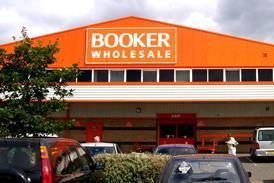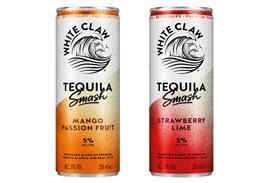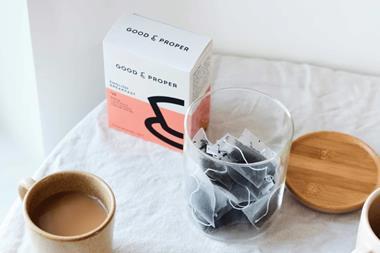We shall fight them on the supermarket shelves. We shall fight them in the tabloids. We shall fight them on the TV. Churchill would be turning in his grave, but this could be the mantra of any one of the big four at the moment. As they each try to assert themselves as the cheapest supermarket , bull(dog)ish advertising and promotional activity has become the norm.
But as with British Bulldog, the kids' playground game banned for being too aggressive, so the current clutch of price comparison adverts and promotions is being criticised for being unfair, heavy handed - or just plain misleading. Last year the Advertising Standards Authority received 448 complaints about supermarket ads - 10 from the big four themselves. And Trading Standards recently launched an investigation into Tesco's promotional practices while Which? published findings on tactics that appear to flout the law.
So are the regulations governing advertising and promotions still fit for purpose in today's price-driven environment? Or are the big four abusing them with such impunity the rule book needs ripping up?
On the face of it, the market looks - if anything - over-regulated. A plethora of self-regulators and government agencies, including the ASA, the OFT, Trading Standards and the European Court of Justice, share responsibility for policing the price war on shelf and in the media. And there are more than 200 separate pieces of UK legislation, some dating back to 1867, covering advertising and promotions.
Regulation is becoming an increasingly "live issue" as more supermarkets push their pricing credentials, agrees Asda chief executive Andy Bond. Asda has already complained to the ASA about price comparison adverts from Tesco and Morrisons this year. However, it was caught out itself last May and was told it would have to have any press ads featuring price comparisons pre-vetted, a sanction that is still in force.
Treading the line between what is acceptable and what is not is easier said than done, admits Bond. "Two years ago each supermarket had a more-or-less unique proposition. Now that price is an increasingly important aspect of consumers' shopping priorities, it's becoming a major aspect of advertising, " he points out.
One issue, Bond says, is differences between regulation for print and broadcast adverts, which are covered by different codes of practice. All broadcast adverts are screened prior to going to air by Clearcast, which advises on potential breaches of the codes. Print adverts, however, are not previewed in the same way. Bond would like to see his rivals subjected to the same scrutiny in this arena as Asda now is. If they are not, it could encourage "print-and-be-damned behaviour", he warns.
"The point is honesty and transparency. Getting there will inevitably lead to retailers challenging each other. On a technical level, that's about who is within the rules and who is not, but the real problem is that the regulations are at best vague," claims Bond. "What we want is a fair and even system - a simple, clear set of rules covering both print and broadcast. At present, even if you act with integrity, it's possible to get yourself in hot water."
But Tesco spokesman Jon Church gives Bond's suggestion short shrift. "It's a bit rich - given Asda's adverts are already pre-screened after they flouted the rules more than once - for them to suggest that others who have stayed within the rules get the same treatment," he says. "We believe the ASA must act quicker to have adverts taken down. A complaint often takes many months to process and by the time of the ruling, people have forgotten about it."
It could become slower still if, as expected, the volume of competitor complaints rises as the big four run more price comparison ads. However, Guy Parker, director of investigations and complaints at the ASA, feels the rules are robust enough to cope. "It is tricky during a price war, as everyone keeps a forensic eye on each other's adverts and jumps in at the first opportunity," he says. "I don't think anyone's entirely innocent or guilty here."
Indeed, the strongest recent sanction was imposed on Asda last year when it broke rules on comparing promotional prices after receiving several warnings. The retailer has been co-operative since the pre-screening was ordered, Parker stresses, admitting that there have been times when the rules were not clear. "There have been issues about verifiability following an ECJ judgment early in 2008," he says. "The codes require price comparison claims to be verifiable, and up until the ECJ decision, we thought we knew what that meant. But the court's view was stricter than ours, and that caught some retailers out ."
As to the issue of pre-screening press adverts, Parker says the real issue is cost. There are more than two billion direct mailings and 30 million press adverts each year, making pre-screening unfeasible. Broadcasters fund pre-screenings of TV and radio adverts, he says, as - unlike print publications - they share legal responsibility for the advertising they show.
Generally, however, there should be no need to pre-screen any ads, he says. "By and large, most of the industry stays on the right side of the code. Saying the rules should cover every issue is, in effect, saying it should be instantly clear whether every complex advert thought up by very creative agencies follows the code. There are too many issues involved."
But advertising is only half the story: many of the same laws apply to in-store promotions and signage, though in this sphere regulation is carried out by Trading Standards. Tesco was caught out in December 2007 for increasing the price of fresh produce before reducing it to create 'artificial' half-price offers - but fresh produce deals were not covered by the code at that time. It is under investigation again this year as Trading Standards works to determine whether advertised alcohol deals were used to 'bait' consumers into stores.
In November, Which? compiled a report on supermarket promotions it felt broke either the letter or spirit of trading guidelines. The consumer group said five offers, in Sainsbury's, Waitrose and Marks & Spencer stores, violated the rules.
"Some were much clearer breaches than others," says Chris Warner, in-house lawyer at Which? "Several were certainly not complying with the spirit of the law, even if they weren't clearly outside the letter."
The lack of clarity that retailers complain of is largely down to a shift in recent months from prescriptive rules to principle-based codes, says Warner. "The new rules represented a move to general ideas," he says. "The benefit is that it's flexible and futureproof. The trade-off is the lack of specific examples while the rules bed in."
The authorities can't win, he says. "Sometimes retailers ask for flexibility, sometimes they complain this approach is unclear. They argue that flexible regulation allows for innovation, but then they complain they don't understand the rules."
From a consumer perspective, he adds, it's more important to ensure rules are not broken than punish people if they are.
However, while Warner says the regulations covering in-store promotions are good in theory, he admits much of the legal underpinning is still untested and enforcement patchy. "The rules offer a good range of protection," he says. "It now comes down to how they work in practice."
At the moment, the reality is that retailers and brands can exploit the regulatory regime. There are a number of ways those that want to promote strongly can get around the regulations, confirms promotions-tracking agency Assosia. Large branded manufacturers with several pack sizes and SKUs can rotate offers between different lines to allow the brand to constantly be discounted for customers not loyal to a particular format, circumventing rules limiting the time any one product can run at a discounted price.
Coca-Cola, for example, was on offer every week in 2008, but rotated through different pack sizes, formats (cans and bottles) and offer types, alternating multibuy with half-price. But while brands and retailers may deliver low price points through workarounds, it's rarely in their interest to actually break rules.
"The major multiples and manufacturers certainly need to stick to the rules as the last thing they need is negative publicity about 'fake' offers," says Assosia managing director Kay Staniland. "With competition among retailers intensifying, there will undoubtedly be more occasions where the promotional price lasts longer than the standard, but this will be as a result of the current climate rather than retailers trying to pull the wool over consumers' eyes.
"Price cuts and savings are what consumers want and what retailers need to give to stay ahead of the competition, so when reviewing the legality of promotions, regulators need to use a degree of common sense to ascertain whether misdemeanours are a result of wilful defiance or a link to competition and economic climate."
As the downturn deepens and retailers rely more heavily on price-led advertising and promotions, they face more legislation, voluntary codes and enforcement bodies.
The ASA and Which?'s argument is that as more cases emerge, the rules - or at least how they are enforced - will become clearer. That may prove the case and the big four are certainly providing plenty of hard evidence - a significant proportion of rulings upheld were the result of complaints between rivals. But they should think before they cry wolf, the ASA warns.
"We want retailers to know we're very serious about trying to get on the front foot in this sector," says Parker. "We do not want to spend the year embroiled in complex and bitterly fought complaints between the supermarkets. We've got other things to be doing."
As, of course, have the retailers.
The price war will be discussed and debated at The Grocer's inaugural Pricing, Promotions and Trade Investment conference on 31 March at the Millennium Gloucester Hotel & Conference Centre in London. Delegates reserving a place before 15 February will be entitled to a discounted rate of £495. For information visit www.ppti.thegrocer.co.uk, call 01293 610 468, or email grocermarketing@william-reed.co.uk
But as with British Bulldog, the kids' playground game banned for being too aggressive, so the current clutch of price comparison adverts and promotions is being criticised for being unfair, heavy handed - or just plain misleading. Last year the Advertising Standards Authority received 448 complaints about supermarket ads - 10 from the big four themselves. And Trading Standards recently launched an investigation into Tesco's promotional practices while Which? published findings on tactics that appear to flout the law.
So are the regulations governing advertising and promotions still fit for purpose in today's price-driven environment? Or are the big four abusing them with such impunity the rule book needs ripping up?
On the face of it, the market looks - if anything - over-regulated. A plethora of self-regulators and government agencies, including the ASA, the OFT, Trading Standards and the European Court of Justice, share responsibility for policing the price war on shelf and in the media. And there are more than 200 separate pieces of UK legislation, some dating back to 1867, covering advertising and promotions.
How to play nice
Don’t exaggerate the length of time prices have been lower
Marketers should state when price comparisons took place
Always hold evidence to back up any comparative claims
If you or the competitor you’re comparing with do not have national pricing policies, state where the prices were checked
If you’re comparing typical weekly shops ensure you give enough information about the products included in the comparison to allow the price difference to be verified
Advertisers in particularly price-sensitive retail sectors should use media with a short shelf life and avoid using media with long copy deadlines
Compare like with like – if you are using your promotional prices then you must compare them with your competitor’s promotional prices, or state really clearly what it is that you are comparing
Use CAP Copy Advice: www.cap.org.uk/020 7492 2100
Source: ASA
But therein lies the problem, suggests a source at one of the big four, who admits enforcement on advertising is sometimes lax. "There's not necessarily any consistency across the board, it often depends who you deal with," he says. "It's a long process to get to an adjudication, and then that just means the advert can't be run in the same form again. There's nothing to prevent a retailer putting out an advert that has little chance of meeting the code and just dealing with the complaint process when it happens, though that's not really in anyone's interest over the long term."Don’t exaggerate the length of time prices have been lower
Marketers should state when price comparisons took place
Always hold evidence to back up any comparative claims
If you or the competitor you’re comparing with do not have national pricing policies, state where the prices were checked
If you’re comparing typical weekly shops ensure you give enough information about the products included in the comparison to allow the price difference to be verified
Advertisers in particularly price-sensitive retail sectors should use media with a short shelf life and avoid using media with long copy deadlines
Compare like with like – if you are using your promotional prices then you must compare them with your competitor’s promotional prices, or state really clearly what it is that you are comparing
Use CAP Copy Advice: www.cap.org.uk/020 7492 2100
Source: ASA
Regulation is becoming an increasingly "live issue" as more supermarkets push their pricing credentials, agrees Asda chief executive Andy Bond. Asda has already complained to the ASA about price comparison adverts from Tesco and Morrisons this year. However, it was caught out itself last May and was told it would have to have any press ads featuring price comparisons pre-vetted, a sanction that is still in force.
Treading the line between what is acceptable and what is not is easier said than done, admits Bond. "Two years ago each supermarket had a more-or-less unique proposition. Now that price is an increasingly important aspect of consumers' shopping priorities, it's becoming a major aspect of advertising, " he points out.
One issue, Bond says, is differences between regulation for print and broadcast adverts, which are covered by different codes of practice. All broadcast adverts are screened prior to going to air by Clearcast, which advises on potential breaches of the codes. Print adverts, however, are not previewed in the same way. Bond would like to see his rivals subjected to the same scrutiny in this arena as Asda now is. If they are not, it could encourage "print-and-be-damned behaviour", he warns.
"The point is honesty and transparency. Getting there will inevitably lead to retailers challenging each other. On a technical level, that's about who is within the rules and who is not, but the real problem is that the regulations are at best vague," claims Bond. "What we want is a fair and even system - a simple, clear set of rules covering both print and broadcast. At present, even if you act with integrity, it's possible to get yourself in hot water."
But Tesco spokesman Jon Church gives Bond's suggestion short shrift. "It's a bit rich - given Asda's adverts are already pre-screened after they flouted the rules more than once - for them to suggest that others who have stayed within the rules get the same treatment," he says. "We believe the ASA must act quicker to have adverts taken down. A complaint often takes many months to process and by the time of the ruling, people have forgotten about it."
It could become slower still if, as expected, the volume of competitor complaints rises as the big four run more price comparison ads. However, Guy Parker, director of investigations and complaints at the ASA, feels the rules are robust enough to cope. "It is tricky during a price war, as everyone keeps a forensic eye on each other's adverts and jumps in at the first opportunity," he says. "I don't think anyone's entirely innocent or guilty here."
The ads that broke the rules - and the ones that might
Morrisons: August ‘07
One person complained about a Morrisons press advert for Philips energy-saving lightbulbs. The ASA noted that comparisons of the energy saving of low-energy bulbs were not clear. It ruled the advert should not appear again in its current form.
Asda: May ‘08
Morrisons objected to Asda’s ‘Dads Army’ price comparison press ads and four of its six complaints were upheld by the ASA. In light of previous rulings on Asda price comparison adverts, the ASA ruled that future Asda press adverts featuring price comparisons should be pre-screened by CAP Copy Advice.
Tesco: August ‘08
The ASA received two complaints about Tesco adverts comparing a trolley of Tesco promotional offers with trolleys of Asda and Morrisons goods. The ASA agreed with the complainants that the adverts implied general price savings at Tesco rather than just on the specific listed offers. They ruled the adverts should not appear again in the same form.
Sainsbury's: December ‘08
Sainsbury's fell foul of the ASA after two complaints over a TV ad promoting offers on vegetables to ‘help on your way to 5-a-day’. Its critical mistake was including potatoes: not one of your five. The ASA upheld the complaint and ruled the advert must not appear again in that form. Since then, Sainsbury's has shifted away from the 5-a-day message.
Morrisons: January ‘09
Morrisons entered the price comparison fray with press adverts celebrating weekly Grocer 33 wins and also its own basket comparison service. Asda complained to the ASA and is awaiting adjudication.
Asda: January ‘09
Asda was the first retailer to fall foul of higher verifiability rules set by the European Court of Justice, after another clash with Morrisons over price comparison ads. The ASA ruled Asda had to make it clearer how customers could verify the prices shown, and must not broadcast or print the adverts again in their current form.
Tesco: January ‘09
Tesco unveiled its new ‘real basket results’ price comparison adverts, the first since its ‘swingometer’ in 2007. Again, these have received complaints and are awaiting adjudication from the ASA.
Though most complaints are informally resolved or dismissed, each of the big four has had at least one ASA ruling against it in the past two years. The usual sanction is a prohibition on running adverts again without making changes to address breaches, but Parker stresses that the ASA is willing to take further action. Its ultimate legal backstop is to refer issues to the OFT, but this has never been imposed on any of the big four.Morrisons: August ‘07
One person complained about a Morrisons press advert for Philips energy-saving lightbulbs. The ASA noted that comparisons of the energy saving of low-energy bulbs were not clear. It ruled the advert should not appear again in its current form.
Asda: May ‘08
Morrisons objected to Asda’s ‘Dads Army’ price comparison press ads and four of its six complaints were upheld by the ASA. In light of previous rulings on Asda price comparison adverts, the ASA ruled that future Asda press adverts featuring price comparisons should be pre-screened by CAP Copy Advice.
Tesco: August ‘08
The ASA received two complaints about Tesco adverts comparing a trolley of Tesco promotional offers with trolleys of Asda and Morrisons goods. The ASA agreed with the complainants that the adverts implied general price savings at Tesco rather than just on the specific listed offers. They ruled the adverts should not appear again in the same form.
Sainsbury's: December ‘08
Sainsbury's fell foul of the ASA after two complaints over a TV ad promoting offers on vegetables to ‘help on your way to 5-a-day’. Its critical mistake was including potatoes: not one of your five. The ASA upheld the complaint and ruled the advert must not appear again in that form. Since then, Sainsbury's has shifted away from the 5-a-day message.
Morrisons: January ‘09
Morrisons entered the price comparison fray with press adverts celebrating weekly Grocer 33 wins and also its own basket comparison service. Asda complained to the ASA and is awaiting adjudication.
Asda: January ‘09
Asda was the first retailer to fall foul of higher verifiability rules set by the European Court of Justice, after another clash with Morrisons over price comparison ads. The ASA ruled Asda had to make it clearer how customers could verify the prices shown, and must not broadcast or print the adverts again in their current form.
Tesco: January ‘09
Tesco unveiled its new ‘real basket results’ price comparison adverts, the first since its ‘swingometer’ in 2007. Again, these have received complaints and are awaiting adjudication from the ASA.
Indeed, the strongest recent sanction was imposed on Asda last year when it broke rules on comparing promotional prices after receiving several warnings. The retailer has been co-operative since the pre-screening was ordered, Parker stresses, admitting that there have been times when the rules were not clear. "There have been issues about verifiability following an ECJ judgment early in 2008," he says. "The codes require price comparison claims to be verifiable, and up until the ECJ decision, we thought we knew what that meant. But the court's view was stricter than ours, and that caught some retailers out ."
As to the issue of pre-screening press adverts, Parker says the real issue is cost. There are more than two billion direct mailings and 30 million press adverts each year, making pre-screening unfeasible. Broadcasters fund pre-screenings of TV and radio adverts, he says, as - unlike print publications - they share legal responsibility for the advertising they show.
Generally, however, there should be no need to pre-screen any ads, he says. "By and large, most of the industry stays on the right side of the code. Saying the rules should cover every issue is, in effect, saying it should be instantly clear whether every complex advert thought up by very creative agencies follows the code. There are too many issues involved."
But advertising is only half the story: many of the same laws apply to in-store promotions and signage, though in this sphere regulation is carried out by Trading Standards. Tesco was caught out in December 2007 for increasing the price of fresh produce before reducing it to create 'artificial' half-price offers - but fresh produce deals were not covered by the code at that time. It is under investigation again this year as Trading Standards works to determine whether advertised alcohol deals were used to 'bait' consumers into stores.
In November, Which? compiled a report on supermarket promotions it felt broke either the letter or spirit of trading guidelines. The consumer group said five offers, in Sainsbury's, Waitrose and Marks & Spencer stores, violated the rules.
"Some were much clearer breaches than others," says Chris Warner, in-house lawyer at Which? "Several were certainly not complying with the spirit of the law, even if they weren't clearly outside the letter."
The lack of clarity that retailers complain of is largely down to a shift in recent months from prescriptive rules to principle-based codes, says Warner. "The new rules represented a move to general ideas," he says. "The benefit is that it's flexible and futureproof. The trade-off is the lack of specific examples while the rules bed in."
The authorities can't win, he says. "Sometimes retailers ask for flexibility, sometimes they complain this approach is unclear. They argue that flexible regulation allows for innovation, but then they complain they don't understand the rules."
From a consumer perspective, he adds, it's more important to ensure rules are not broken than punish people if they are.
However, while Warner says the regulations covering in-store promotions are good in theory, he admits much of the legal underpinning is still untested and enforcement patchy. "The rules offer a good range of protection," he says. "It now comes down to how they work in practice."
At the moment, the reality is that retailers and brands can exploit the regulatory regime. There are a number of ways those that want to promote strongly can get around the regulations, confirms promotions-tracking agency Assosia. Large branded manufacturers with several pack sizes and SKUs can rotate offers between different lines to allow the brand to constantly be discounted for customers not loyal to a particular format, circumventing rules limiting the time any one product can run at a discounted price.
Coca-Cola, for example, was on offer every week in 2008, but rotated through different pack sizes, formats (cans and bottles) and offer types, alternating multibuy with half-price. But while brands and retailers may deliver low price points through workarounds, it's rarely in their interest to actually break rules.
"The major multiples and manufacturers certainly need to stick to the rules as the last thing they need is negative publicity about 'fake' offers," says Assosia managing director Kay Staniland. "With competition among retailers intensifying, there will undoubtedly be more occasions where the promotional price lasts longer than the standard, but this will be as a result of the current climate rather than retailers trying to pull the wool over consumers' eyes.
"Price cuts and savings are what consumers want and what retailers need to give to stay ahead of the competition, so when reviewing the legality of promotions, regulators need to use a degree of common sense to ascertain whether misdemeanours are a result of wilful defiance or a link to competition and economic climate."
As the downturn deepens and retailers rely more heavily on price-led advertising and promotions, they face more legislation, voluntary codes and enforcement bodies.
The ASA and Which?'s argument is that as more cases emerge, the rules - or at least how they are enforced - will become clearer. That may prove the case and the big four are certainly providing plenty of hard evidence - a significant proportion of rulings upheld were the result of complaints between rivals. But they should think before they cry wolf, the ASA warns.
"We want retailers to know we're very serious about trying to get on the front foot in this sector," says Parker. "We do not want to spend the year embroiled in complex and bitterly fought complaints between the supermarkets. We've got other things to be doing."
As, of course, have the retailers.
The price war will be discussed and debated at The Grocer's inaugural Pricing, Promotions and Trade Investment conference on 31 March at the Millennium Gloucester Hotel & Conference Centre in London. Delegates reserving a place before 15 February will be entitled to a discounted rate of £495. For information visit www.ppti.thegrocer.co.uk, call 01293 610 468, or email grocermarketing@william-reed.co.uk














No comments yet